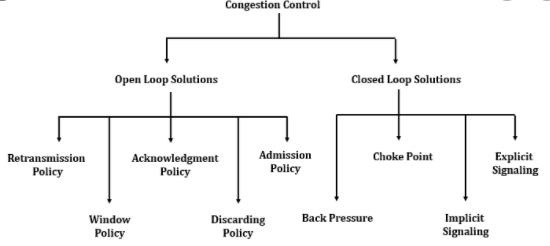
 Data Structure
Data Structure Networking
Networking RDBMS
RDBMS Operating System
Operating System Java
Java MS Excel
MS Excel iOS
iOS HTML
HTML CSS
CSS Android
Android Python
Python C Programming
C Programming C++
C++ C#
C# MongoDB
MongoDB MySQL
MySQL Javascript
Javascript PHP
PHP
- Selected Reading
- UPSC IAS Exams Notes
- Developer's Best Practices
- Questions and Answers
- Effective Resume Writing
- HR Interview Questions
- Computer Glossary
- Who is Who
What is Open Loop Congestion Control?
The reduction in the quality of service that occurs when a network node or a link carries more data than it can handle is called “Network Congestion”. The congestion in the network can lead to effects like packet loss or even blocking of new connections.
Therefore, congestion in networks can be defined as, “A state that occurs in network layers because of the heavy message traffic that results in slowing down the network response time is called congestion”.
Effects of Congestion
Following are the effects of Congestion −
Because of the increase in the response time, the overall performance is reduced.
Also, in worst situations, because of the delay that takes place, re-transmission can also occur which worsens the scenario.
Classification of Congestion
The broader ways to classify the congestions are as follows −
Practical network congestion
TCP/IP congestion
Congestion Control techniques
To control the congestion in networks, the control techniques are broadly classified under two categories, which are as follows −
The Open loop refers to the protocols that should be used in order to prevent congestion. That is, the congestion should not occur in the first place. This is based on the technique of having a good design implementation in order to prevent the congestion from taking place.
The Close loop allows the system to enter in the congestion state if it occurs, detects it and then proceeds to remove the congestion. This is based on the feedback mechanism that is received. With the help of the feedback, one can detect and remove the congestion from the network.

Now let us discuss about open loop congestion control in detail −
Open Loop Congestion Control
In this control policies are applied to prevent congestion before it happens. It is handled either by the source or the destination.
Retransmission Policy − This type of policy is sometimes unavoidable. If the sender feels that a packet is lost or corrupted, then it thinks to retransmit. So, a retransmission policy can prevent congestion.
Window Policy − In this type of window the sender may also affect congestion. The selective repeat window is better than the Go-Back-N window for congestion control. In the Go-Back-N window, when the timer for a packet times out, a number of packets may be resent, although some may have arrived safe and sound at the receiver.
Acknowledgement Policy − This policy imposed by the receiver may also affect congestion. If the receiver does not acknowledge every packet it receives, it may slow down the sender and help prevent congestion. A receiver may send an acknowledgment only if it has a packet to be sent or a special timer expires. A receiver may decide to acknowledge only N packets at a time.
Discarding Policy − A discarding policy by the routers prevents congestion and at the same time may not harm the integrity of the transmission.
Admission Policy − An admission policy is a quality-of-service mechanism, which prevents congestion in virtual circuit networks.

